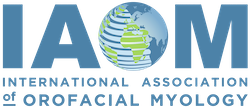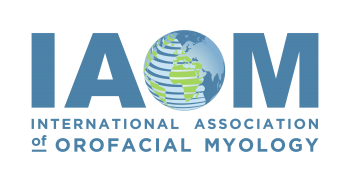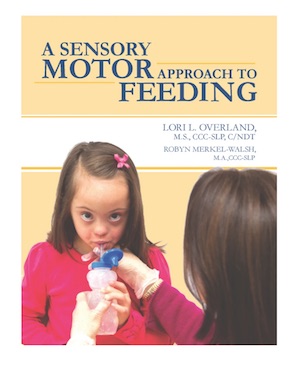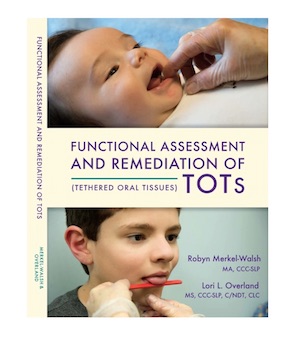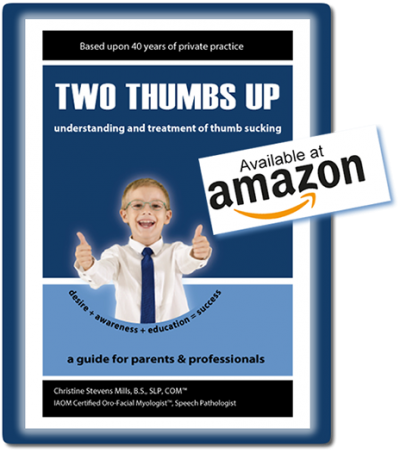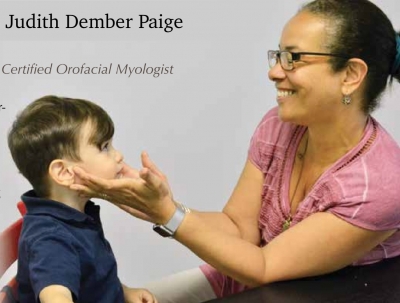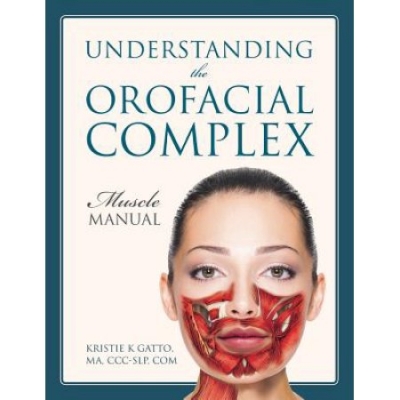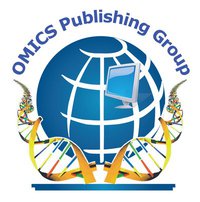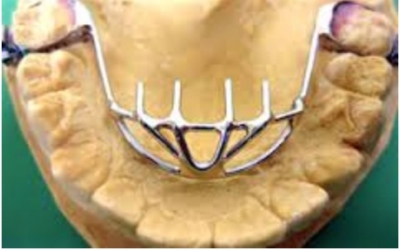Two Thumbs Up: Understanding and Treatment of Thumb Sucking
Two Thumbs Up is an accumulation of Christine’s experiences and orofacial myology expertise comprised of forty years in private practice, eighteen years teaching at University of Detroit Mercy orthodontic department, and teaching COM® (Certified Orofacial Myologist) Certification Track Courses. Two Thumbs Up understanding and treatment of thumb sucking a Guide for Parents and Professionals by Christine Stevens Mills takes an in-depth look at the complexity of thumb sucking, complications and ramifications related to the oro-facial structures and beyond. Connections are made between chronic sucking patterns and possible changes in structures and functions, breathing patterns, rest postures, speech, and unrealized educational, social, emotional, and family dynamic complications that develop.Thumb sucking is more than Just a Simple Habit.…
Understanding the Orofacial Complex: Muscle Manual
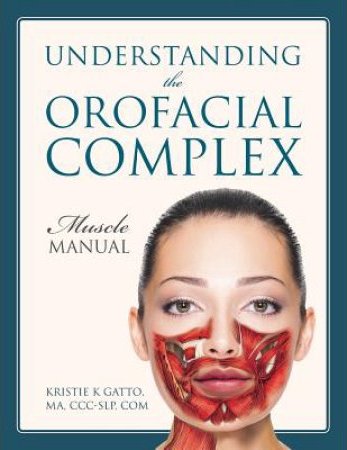 Understanding the Orofacial Complex: Muscle Manual was written to familiarize the reader with the anatomy and physiology of the orofacial musculature. Professionals who work with clients exhibiting deficits of the orofacial complex require a clear understanding of the typical muscle functions that occur in the act of swallowing and speech to more properly diagnose and treat the disorders associated. The orofacial complex consists of the muscles of the jaw, lips, tongue, soft palate, and larynx. This manual provides comprehensive illustrations of each muscle with descriptions of the anatomical maps for those muscles. The maps also discuss the origin, insertion, function of the muscle, as well as the cranial nerve innervation associated, allowing the reader to more easily comprehend the anatomy and associated physiology.…
Understanding the Orofacial Complex: Muscle Manual was written to familiarize the reader with the anatomy and physiology of the orofacial musculature. Professionals who work with clients exhibiting deficits of the orofacial complex require a clear understanding of the typical muscle functions that occur in the act of swallowing and speech to more properly diagnose and treat the disorders associated. The orofacial complex consists of the muscles of the jaw, lips, tongue, soft palate, and larynx. This manual provides comprehensive illustrations of each muscle with descriptions of the anatomical maps for those muscles. The maps also discuss the origin, insertion, function of the muscle, as well as the cranial nerve innervation associated, allowing the reader to more easily comprehend the anatomy and associated physiology.…
Oral Rest Posture: A key piece of the obstructive sleep apnea puzzle
Dental professionals are missing the chance to address obstructive sleep apnea before it even begins.
In the past few years, the subject of the airway in relation to dentistry has been increasingly discussed. Obstructive sleep apnea (OSA) and snoring are hot topics right now. There seems to be a call to action for all dental professionals to assess our patients for snoring and sleep apnea. Mandibular advancement devices and take-home sleep studies are definitely trending in the dental world.
The spotlight on this issue is necessary and important. But rather than focus all of our attention on the treatment modalities that dental professionals can offer for snoring and sleep apnea, what if we shifted our focus to how we can help to prevent these issues in the first place? …
Why Can’t My Child’s Tongue Thrust be Treated at School?
Parents often ask: “Why can’t my child’s tongue thrust be treated at school?” When parents discover that a tongue thrust is often treated by a Speech/Language Pathologist (SLP) they assume that the speech therapist at their child’s school has been trained to do therapy with tongue thrust just as they were trained to treat other speech problems. Unfortunately, this is not true. At the present time, there are very few graduate programs of Speech Pathology that even address tongue thrust problems in their courses.
By law, a child can only be seen in the public schools by a speech therapist for an educationally handicapping condition.…
Otolaryngology: Open Access
Orofacial Myofunctional Disorders and Otolaryngologists
Robert M. Mason
Emeritus Professor of Surgery, Previous Chief of Orthodontics, Duke University Medical Center, Department of Surgery, Durham, NC
Honor Franklin
Private Practice in Orofacial Myology and Speech-Language Pathology, Dallas, Texas
Corresponding Author :
Robert M. Mason, DMD, PhD
Email: oitsbob@sc.rr.com
Received October14, 2014; Accepted October 16, 2014; Published October 26, 2014
Citation: Mason RM, Franklin H (2014) Orofacial Myofunctional Disorders and Otolaryngologists. Otolaryngol (Sunnyvale) 4:e110. doi: 10.4172/2161-119X.1000e110
Copyright: © 2014 Mason RM, et al. This is an open-access article distributed under the terms of the Creative Commons Attribution License, which permits unrestricted use, distribution, and reproduction in any medium, provided the original author and source are credited.…
Relapse of Anterior Open Bites Treated With Orthodontic Appliances With and Without Orofacial Myofunctional Therapy
Introduction
Closure and long-term retention of anterior open bites are significant concerns for orthodontists and their patients. In this study, we investigated the efficacy of orofacial myofunctional therapy (OMT) for maintaining closure of open bites in conjunction with orthodontic treatment.
Methods
The sample included 76 subjects with dental anterior open bites referred for OMT before, during, or after relapse of orthodontic treatment. The experimental cohort consisted of 27 subjects who received OMT and orthodontic treatment or retreatment. The control cohort comprised 49 subjects who had a history of orthodontic treatment with open-bite relapse. Overbite was evaluated by an OMT professional or orthodontist 2 months to 23 years after removal of the fixed appliances.…
Appliance Use for Oral Habit Patterns.
Position statement of the IAOM regarding appliance use for the Oral Habit Patterns.
Prepared by:
Robert M. Mason, DMD, PhD
Honor Franklin, PhD
BACKGROUND: Some orthodontists and others in dentistry continue to address oral habit patterns with appliances involving cribs, rakes, spikes, prongs or other tongue reminders. By contrast, procedures utilized by orofacial myologists are effective in modifying oral habit patterns without the need for appliances.
NEGATIVE ASPECTS OF HABIT APPLIANCES:
- Most habit appliances are designed to block a tongue thrust (swallow) rather than to modify the rest posture of the tongue and address the problem of inability to close the lips.
The Use of Post Nominal Letters: A much more serious issue than many are aware of.
Author: Lorraine Frey RDH, LDH, BAS, COM®, FAADH
Licensed healthcare professionals are held to specific standards of care and allowable duties in the area they are licensed to practice. Likewise, the creden- tials one may use after their name must be legitimately earned. In the realm of orofacial myofunctional therapy, it is becoming increasingly common for some individuals to use the letters “OMT” after their “RDH” credential.
A legitimate credential is one that is earned from an academic institution or a recognized professional organization. A licensed professional cannot create their own credentials, by selecting letters to represent what they do, and place them after their name.…
That Adorable Thumb
By Shari Green, COM®
That adorable baby with their thumb in their mouth…truly a precious sight to behold. But, what happens when that habit continues a bit too long? Should parents become concerned? After all, they will grow out of it anyway, won’t they? Well, not necessarily.
Childhood sucking past age five is a habit. A habit that has roots in the very earliest days of life. Childhood sucking is a pleasurable activity from day one, often associated with early pleasurable innate physiological responses. This is the essence of why it is so hard for some children to stop their habit easily.…
